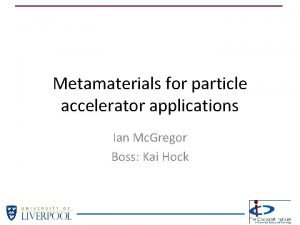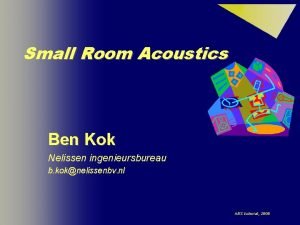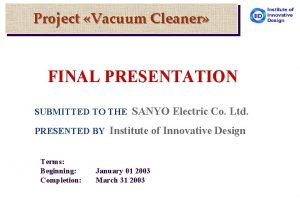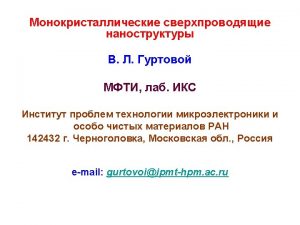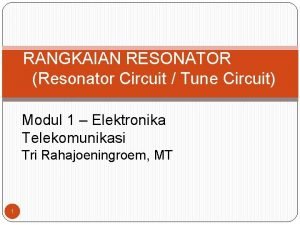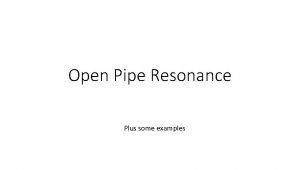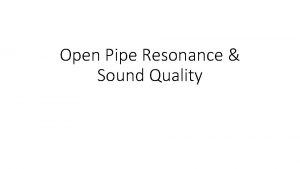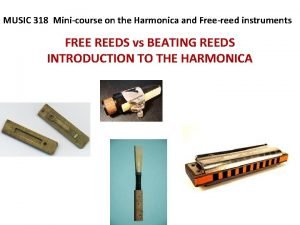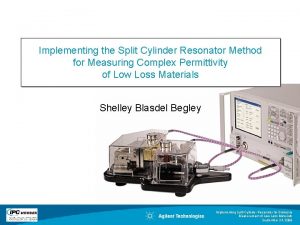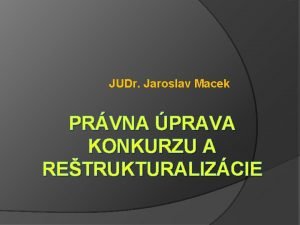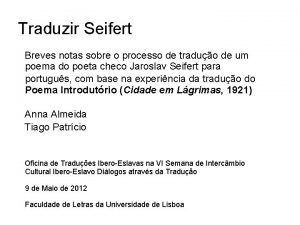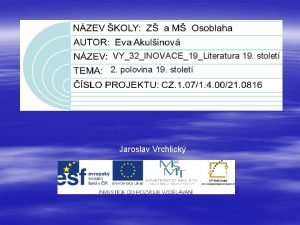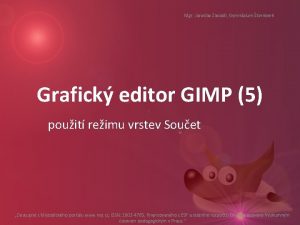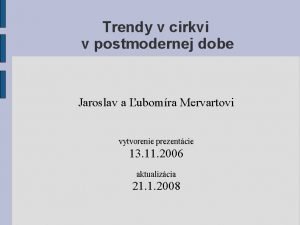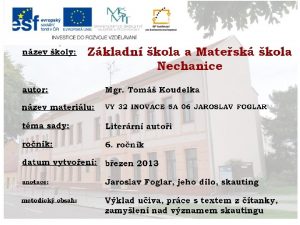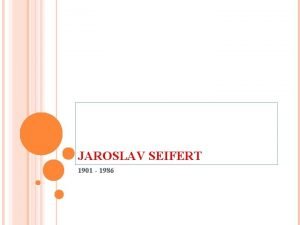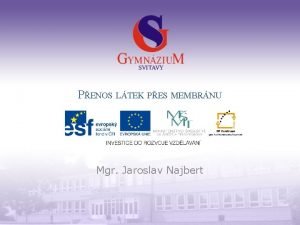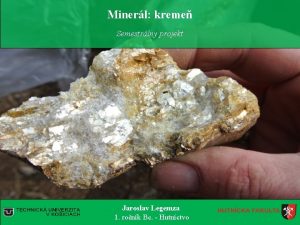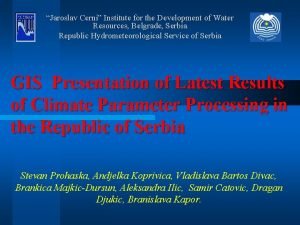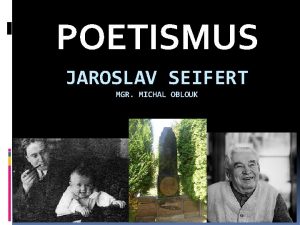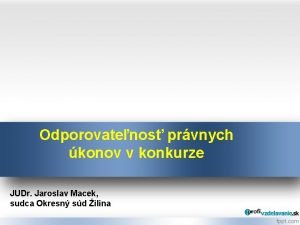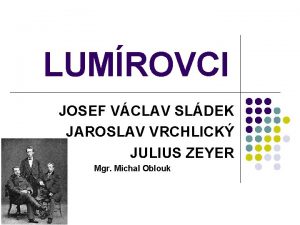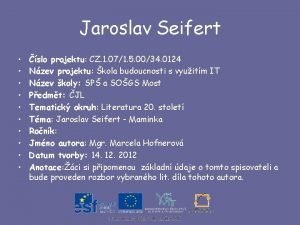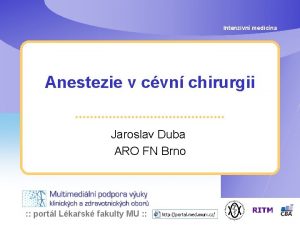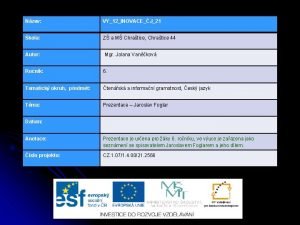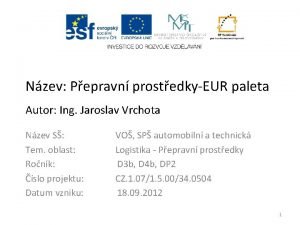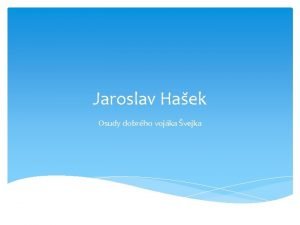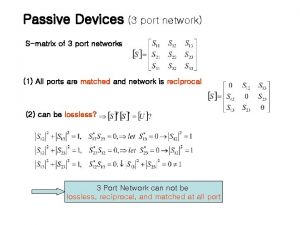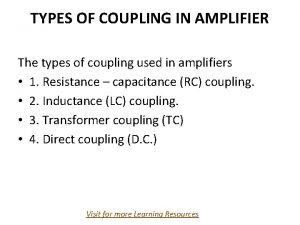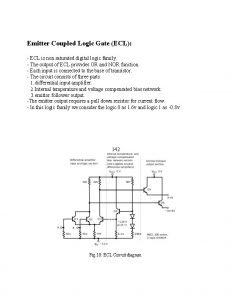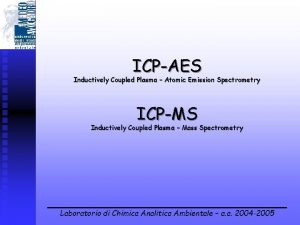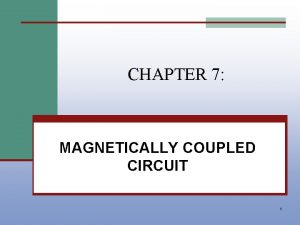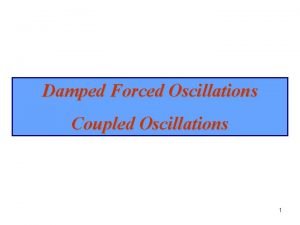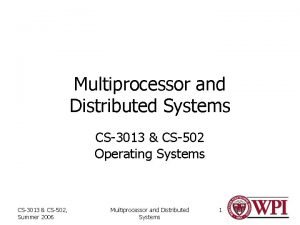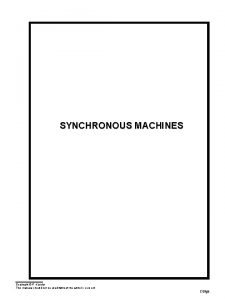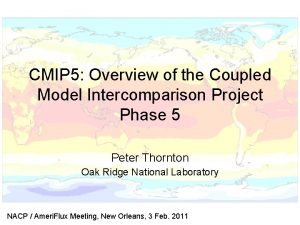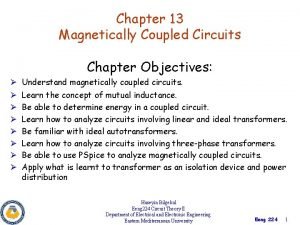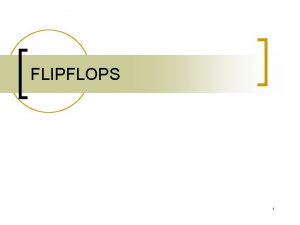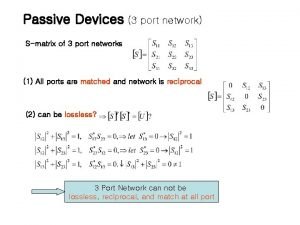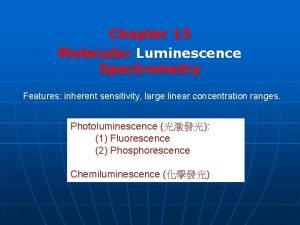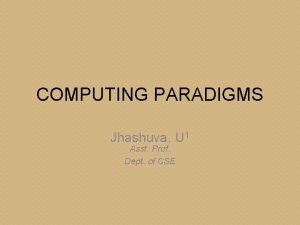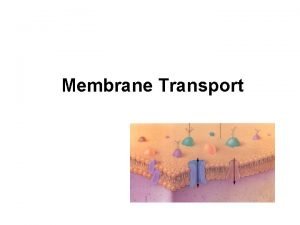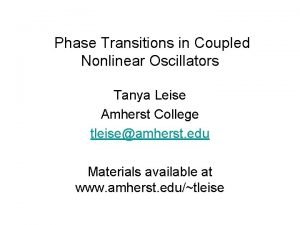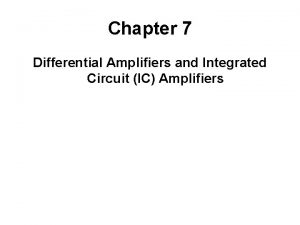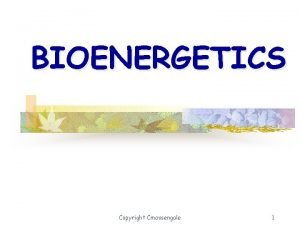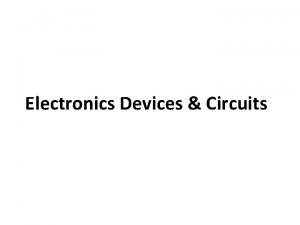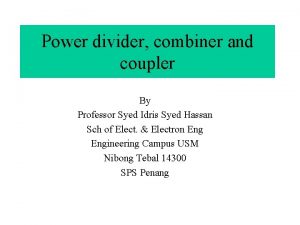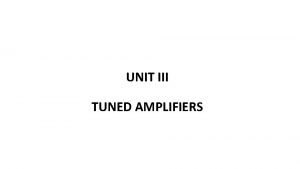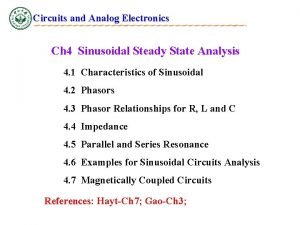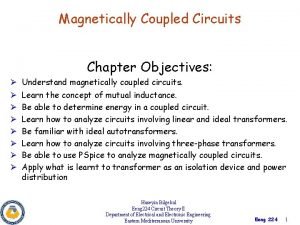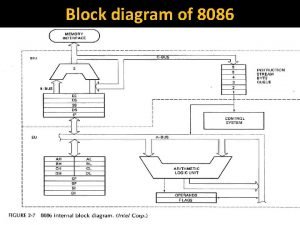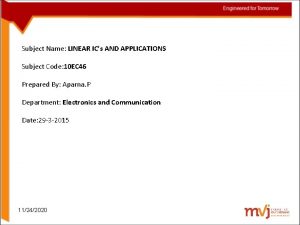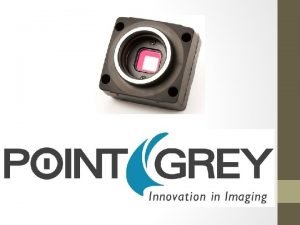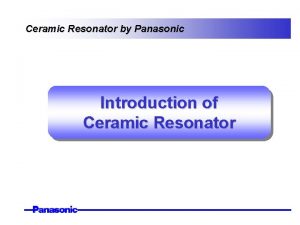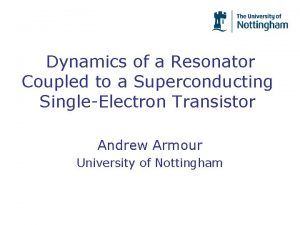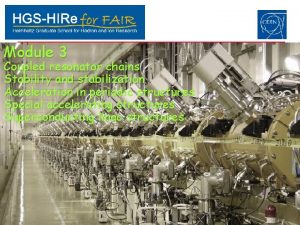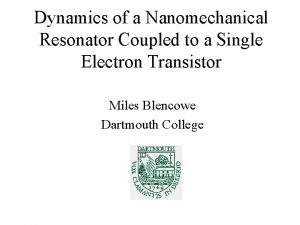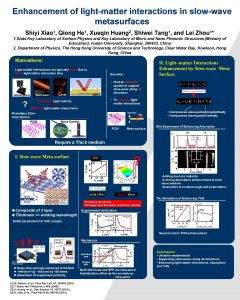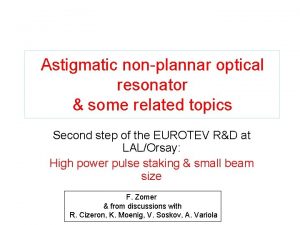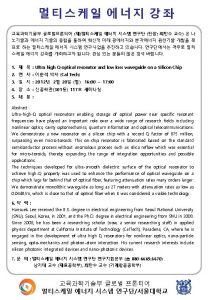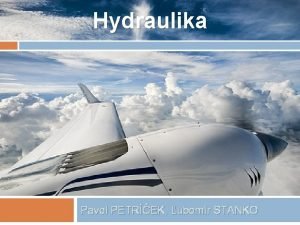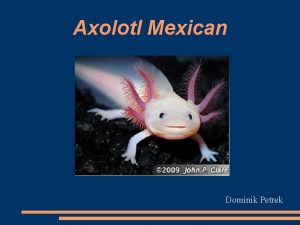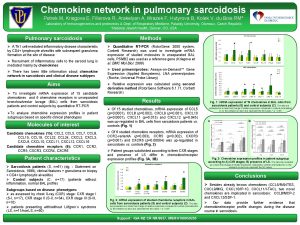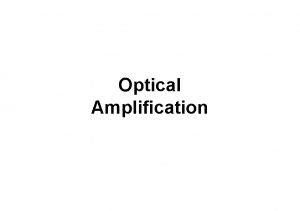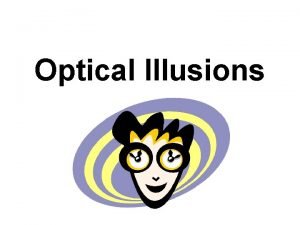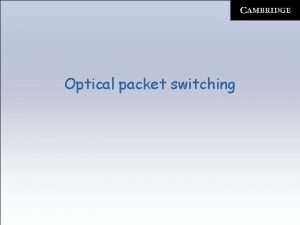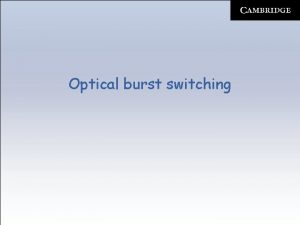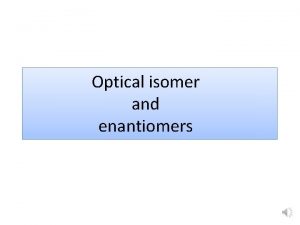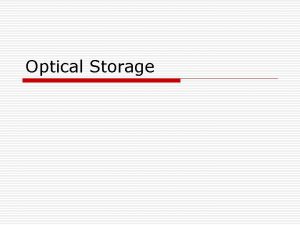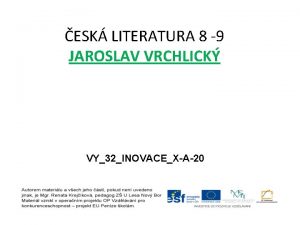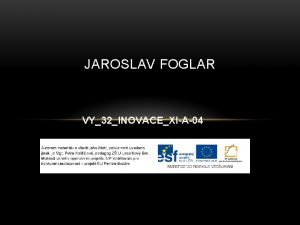Coupled resonator slowwave optical structures Ji Petrek Jaroslav





























































- Slides: 61

Coupled resonator slow-wave optical structures Jiří Petráček, Jaroslav Čáp petracek@fme. vutbr. cz Parma, 5/6/2007

all-optical high-bit-rate communication systems - optical delay lines - memories - switches - logic gates -. . “slow” light nonlinear effects increased efficiency

Outline • Introduction: slow-wave optical structures (SWS) • Basic properties of SWS – – – System model Bloch modes Dispersion characteristics Phase shift enhancement Nonlinear SWS • Numerical methods for nonlinear SWS – NI-FD – FD-TD • Results for nonlinear SWS

Outline • Introduction: slow-wave optical structures (SWS) • Basic properties of SWS – – – System model Bloch modes Dispersion characteristics Phase shift enhancement Nonlinear SWS • Numerical methods for nonlinear SWS – NI-FD – FD-TD • Results for nonlinear SWS

Slow light • the light speed in vacuum c • phase velocity v • group velocity vg

How to reduce the group velocity of light? Electromagnetically induced transparency - EIT Ch. Liu, Z. Dutton, et al. : „Observation of coherent optical information storage in an atomic medium using halted light pulses, “ Nature 409 (2001) 490 -493 Stimulated Brillouin scattering Miguel González Herráez, Kwang Yong Song, Luc Thévenaz: „Arbitrary bandwidth Brillouin slow light in optical fibers, “ Opt. Express 14 1395 (2006) Slow-wave optical structures (SWS) – – pure optical way A. Melloni and F. Morichetti, “Linear and nonlinear pulse propagation in coupled resonator slow-wave optical structures, ” Opt. And Quantum Electron. 35, 365 (2003).

Slow-wave optical structure (SWS) - chain of directly coupled resonators (CROW - coupled resonator optical waveguide) - light propagates due to the coupling between adjacent resonators

Various implementations of SWSs coupled Fabry-Pérot cavities 1 D coupled PC defects 2 D coupled PC defects coupled microring resonators

Outline • Introduction: slow-wave optical structures (SWS) • Basic properties of SWS – – – System model Bloch modes Dispersion characteristics Phase shift enhancement Nonlinear SWS • Numerical methods for nonlinear SWS – NI-FD – FD-TD • Results for nonlinear SWS

System model of SWS A. Melloni and F. Morichetti, “Linear and nonlinear pulse propagation in coupled resonator slow-wave optical structures, ” Opt. And Quantum Electron. 35, 365 (2003). J. K. S. Poon, J. Scheuer, Y. Xu and A. Yariv, “Designing coupled-resonator optical waveguide delay lines", J. Opt. Soc. Am. B 21, 1665 -1673, 2004.

System model of SWS

Relation between amplitudes

Transmission matrix

For lossless SWS it follows from symmetry: real – (coupling ratio) real

Propagation in periodic structure

Bloch modes eigenvalue eq. for the propagation constant of Bloch modes A. Melloni and F. Morichetti, “Linear and nonlinear pulse propagation in coupled resonator slow-wave optical structures, ” Opt. And Quantum Electron. 35, 365 (2003). J. K. S. Poon, J. Scheuer, Y. Xu and A. Yariv, “Designing coupled-resonator optical waveguide delay lines", J. Opt. Soc. Am. B 21, 1665 -1673, 2004.

Dispersion curves (band diagram)

Dispersion curves

Bandwidth, B at the edges of pass-band

Group velocity for resonance frequency

Group velocity GVD: very strong minimal very strong

Infinite vs. finite structure dispersion relation Jacob Scheuer, Joyce K. S. Poonb, George T. Paloczic and Amnon Yariv, “Coupled Resonator Optical Waveguides (CROWs), ” www. its. caltech. edu/~koby/

COST P 11 task on slow-wave structures One period of the slow-wave structure consists of one-dimensional Fabry-Perot cavity placed between two distributed Bragg reflectors DBR

Finite structure consisting 1, 3 and 5 resonators 3 5

Fengnian Xia, a Lidija Sekaric, Martin O’Boyle, and Yurii Vlasov: “Coupled resonator optical waveguides based on silicon-on-insulator photonic wires, ” Applied Physics Letters 89, 041122 2006.

experiment number of resonators theory 1550 nm Fengnian Xia, a Lidija Sekaric, Martin O’Boyle, and Yurii Vlasov: “Coupled resonator optical waveguides based on silicon-on-insulator photonic wires, ” Applied Physics Letters 89, 041122 2006.

Fengnian Xia, a Lidija Sekaric, Martin O’Boyle, and Yurii Vlasov: “Coupled resonator optical waveguides based on silicon-on-insulator photonic wires, ” Applied Physics Letters 89, 041122 2006.

Delay, losses and bandwidth loss per unit length loss (usable bandwidth, small coupling) Jacob Scheuer, Joyce K. S. Poon, George T. Paloczi and Amnon Yariv, “Coupled Resonator Optical Waveguides (CROWs), ” www. its. caltech. edu/~koby/

Tradeoffs among delay, losses and bandwidth 10 resonators FSR = 310 GHz propagation loss = 4 d. B/cm Jacob Scheuer, Joyce K. S. Poon, George T. Paloczi and Amnon Yariv, “Coupled Resonator Optical Waveguides (CROWs), ” www. its. caltech. edu/~koby/

Phase shift. . . effective phase shift experienced by the optical field propagating in SWS over a distance d . . . is enhanced by the slowing factor

Nonlinear phase shift § intensity dependent phase shift is induced through SPM and XPM § intensities of forward and backward propagating waves inside cavities of SWS are increased (compared to the uniform structure) and this causes additional enhancement of nonlinear phase shift Total enhancement: J. E. Heebner and R. W. Boyd, JOSA B 4, 722 -731, 2002

Advantage of non-linear SWS: nonlinear processes are enhanced without affecting bandwidth S. Blair, “Nonlinear sensitivity enhancement with one-dimensional photonic bandgap structures, ” Opt. Lett. 27 (2002) 613 -615. A. Melloni, F. Morichetti, M. Martinelli, „Linear and nonlinear pulse propagation in coupled resonator slow-wave optical structures, “ Opt. Quantum Electron. 35 (2003) 365.

Outline • Introduction: slow-wave optical structures (SWS) • Basic properties of SWS – – – System model Bloch modes Dispersion characteristics Phase shift enhancement Nonlinear SWS • Numerical methods for nonlinear SWS – NI-FD – FD-TD • Results for nonlinear SWS

COST P 11 task on slow-wave structures One period of the slow-wave structure consists of one-dimensional Fabry-Perot cavity placed between two distributed Bragg reflectors DBR Kerr non-linear layers

Integration of Maxwell Eqs. in frequency domain One-dimensional structure: - Maxwell equations turn into a system of two coupled ordinary differential equations - that can be solved with standard numerical routines (Runge-Kutta). H. V. Baghdasaryan and T. M. Knyazyan, “Problem of plane EM wave self-action in multilayer structure: an exact solution, “ Opt. Quantum Electron. 31 (1999), 1059 -1072. M. Midrio, “Shooting technique for the computation of plane-wave reflection and transmission through one-dimensional nonlinear inhomogenous dielectric structures, ” J. Opt. Soc. Am. B 18 (2001), 1866 -1981. P. K. Kwan, Y. Y. Lu, “Computing optical bistability in one-dimensional nonlinear structures“ Opt. Commun. 238 (2004) 169174. J. Petráček: „Modelling of one-dimensional nonlinear periodic structures by direct integration of Maxwell’s equations in frequency domain. “ In: Frontiers in Planar Lightwave Circuit Technology (Eds: S. Janz, J. Čtyroký, S. Tanev) Springer, 2005.

Maxwell Eqs. Now it is necessary to formulate boundary conditions.

Analytic solution in linear outer layers

Boundary conditions

Admittance/Impedance concept E. F. Kuester, D. C. Chang, “Propagation, Attenuation, and Dispersion Characteristics of Inhomogenous Dielectric Slab Waveguides, ” IEEE Trans. Microwave Theory Tech. MTT-23 (1975), 98 -106. J. Petráček: „Frequency-domain simulation of electromagnetic wave propagation in one-dimensional nonlinear structures, “ Optics Communications 265 (2006) 331 -335.

new ODE systems for and The equations can be decoupled in case of lossless structures (real n)

Lossless structures (real n) is conserved decoupled

Technique known ? ?

Advantage Speed - for lossless structures – only 1 equation Disadvantage Switching between p and q formulation during the numerical integration

FD-TD

FD-TD: phase velocity corrected algorithm A. Christ, J. Fröhlich, and N. Kuster, IEICE Trans. Commun. , Vol. E 85 -B (12), 2904 -2915 (2002).

FD-TD: convergence common formulation corrected algorithm

Outline • Introduction: slow-wave optical structures (SWS) • Basic properties of SWS – – – System model Bloch modes Dispersion characteristics Phase shift enhancement Nonlinear SWS • Numerical methods for nonlinear SWS – NI-FD – FD-TD • Results for nonlinear SWS

Results for COST P 11 SWS structure is the same in both layers nonlinearity level F. Morichetti, A. Melloni, J. Čáp, J. Petráček, P. Bienstman, G. Priem, B. Maes, M. Lauritano, G. Bellanca, „Self-phase modulation in slow-wave structures: A comparative numerical analysis, “ Optical and Quantum Electronics 38, 761 -780 (2006).

Transmission spectra

1 period

2 periods

3 periods

Transmittance λ =1. 5505 μm normalized incident intensity

Here incident intensity is about 10 -6 However usually 10 -4 - 10 -3 P. K. Kwan, Y. Y. Lu, “Computing optical bistability in one-dimensional nonlinear structures“ Opt. Commun. 238 (2004) 169 -174. W. Ding, “Broadband optical bistable switching in one-dimensional nonlinear cavity structure, ” Opt. Commun. 246 (2005) 147 -152. J. He and M. Cada , ”Optical Bistability in Semiconductor Periodic structures, ” IEEE J. Quant. Electron. 27 (1991), 1182 -1188. S. Blair, “Nonlinear sensitivity enhancement with one-dimensional photonic bandgap structures, ” Opt. Lett. 27 (2002) 613 -615. A. Suryanto et al. , “A finite element scheme to study the nonlinear optical response of a finite grating without and with defect, ” Opt. Quant. Electron. 35 (2003), 313 -332. 10 -2 L. Brzozowski and E. H. Sargent, “Nonlinear distributed-feedback structures as passive optical limiters, ” JOSA B 17 (2000) 1360 -1365.

Here incident intensity is about 10 -6 However usually 10 -4 - 10 -3 Upper limit of the most transparent materials 10 -4 S. Blair, “Nonlinear sensitivity enhancement with one-dimensional photonic bandgap structures, ” Opt. Lett. 27 (2002) 613 -615. Are the high intensity effects important? (e. g. multiphoton absorption)

normalized incident intensity Maximum normalized intensity inside the structure

2 periods

3 periods

Selfpulsing

Selfpulsing

Conclusion SWS could play an important role in the development of nonlinear optical components suitable for all-optical high-bit-rate communication systems.
 Complementary split ring resonator
Complementary split ring resonator Aes resonator
Aes resonator Vacuum cleaner project ppt
Vacuum cleaner project ppt Lumped element resonator
Lumped element resonator Rangkaian induktor
Rangkaian induktor Open pipe resonator example
Open pipe resonator example Half open pipe
Half open pipe Harmonica resonator
Harmonica resonator Split cylinder resonator
Split cylinder resonator Judr jaroslav macek
Judr jaroslav macek Jaroslav seifert poemas
Jaroslav seifert poemas Jaroslav vrchlický prezentace
Jaroslav vrchlický prezentace Jaroslav zavadil
Jaroslav zavadil Jaroslav kříž pastor
Jaroslav kříž pastor Jaroslav foglar wikipedie
Jaroslav foglar wikipedie Jaroslav seifert vzpomínková próza
Jaroslav seifert vzpomínková próza Ententyky říkanka
Ententyky říkanka Jaroslav najbert
Jaroslav najbert Jaroslav duba
Jaroslav duba Odrody kremena
Odrody kremena Jcerni
Jcerni Kytička fialek seifert
Kytička fialek seifert Jaroslav seifert poetismus
Jaroslav seifert poetismus Jaroslav macek sudca
Jaroslav macek sudca Zeyer
Zeyer Prstýnek po mamince
Prstýnek po mamince Dubaaro
Dubaaro Jaroslav foglar prezentace
Jaroslav foglar prezentace Jaroslav vrchota
Jaroslav vrchota Jaroslav hašek prezentace
Jaroslav hašek prezentace Homology
Homology Coupled line coupler
Coupled line coupler Types of coupling in amplifier
Types of coupling in amplifier Ecl emitter coupled logic
Ecl emitter coupled logic Delta g = rt ln(q/k)
Delta g = rt ln(q/k) Inductively coupled plasma
Inductively coupled plasma Highly aligned loosely coupled
Highly aligned loosely coupled Magnetically coupled circuits lecture notes
Magnetically coupled circuits lecture notes Velocity resonance
Velocity resonance Tightly coupled multiprocessor
Tightly coupled multiprocessor Coupled circuit
Coupled circuit Coupled model intercomparison project phase 5
Coupled model intercomparison project phase 5 Coupled circuits
Coupled circuits Cross coupled nor gates
Cross coupled nor gates Coupled line coupler
Coupled line coupler All resources are tightly coupled in computing paradigm of
All resources are tightly coupled in computing paradigm of Charge coupled device detector
Charge coupled device detector All resources are tightly coupled in computing paradigm of
All resources are tightly coupled in computing paradigm of Membrane transport
Membrane transport Tanya leise amherst
Tanya leise amherst Emitter coupled differential amplifier
Emitter coupled differential amplifier Coupled reaction
Coupled reaction Multistage amplifier
Multistage amplifier Netflix freedom and responsibility
Netflix freedom and responsibility Coupled line coupler
Coupled line coupler Single tuned capacitive coupled amplifier
Single tuned capacitive coupled amplifier Complex impedances
Complex impedances Coupled circuits
Coupled circuits Block diagram 8086
Block diagram 8086 Capacitor coupled inverting amplifier
Capacitor coupled inverting amplifier Charge coupled device
Charge coupled device Claims of value examples
Claims of value examples
